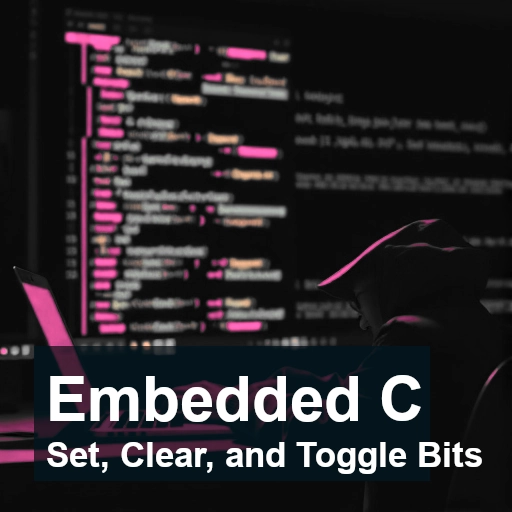In embedded systems programming, manipulating individual bits in a byte or word is a common and essential task. Often, you may need to modify specific bits in a register or a memory location. This is where operations like setting, clearing, and toggling bits become important. These operations are fundamental in low-level programming, particularly when working with hardware registers, configuration bits, flags, or status indicators.
In this article, we will discuss how to set, clear, and toggle bits in embedded C, using simple bitwise operations.
Understanding Bits and Bitwise Operations
Before diving into specific operations, let’s briefly review what bits and bitwise operations are:
- Bit: The smallest unit of data in computing, representing a state of either 0 (low) or 1 (high).
- Bitwise Operations: Operations that directly manipulate individual bits of a value. In C, these operations are performed using bitwise operators:
- AND (&)
- OR (|)
- XOR (^)
- NOT (~)
- Shift left (<<) Shift right (>>)
Setting a Bit:
Setting a bit means changing a specific bit in a variable or register to 1, regardless of its current value
How to Set a Bit: Setting a bit means changing a specific bit to 1, regardless of its current value (whether it’s 0 or 1)
// Set the nth bit of register PortA
PortA |= (1 << n);
// Set multiple bits (ni and n2) of register
PortA |= ((1 << n1) | (1 << n2));Clearing a Bit:
Clearing a bit means changing a specific bit in a variable or register to 0, regardless of its current value.
How to clear a Bit: To clear a bit at a specific position, use the bitwise AND (&) operator along with the bitwise NOT (~) operator.
// Clear single bit
PortA &= ~(1 << n);
// To clear muliple bits
PortA &= ~((1 << n1) |(1 << n2));Toggling Bits :
Toggling a bit means flipping its value: if the bit is 0, it becomes 1, and if the bit is 1, it becomes 0. This operation is often used in cases where a bit needs to alternate between two states.
How to toggle a Bit:To toggle a bit, use the bitwise XOR (^) operator.
// Set the nth bit of register PortA
PortA ^= (1 << n);
// Set multiple bits (ni and n2) of register
PortA ^= ((1 << n1) | (1 << n2));How to Find Particular bit is Set or clear
To check if a particular bit is set (i.e., 1) or clear (i.e., 0), you can use the bitwise AND operation in C. The basic idea is to mask the specific bit you are interested in, then check the result.
#include <stdio.h>
int main() {
unsigned int x = 5; // 0101 in binary
int n = 2; // Check the 2nd bit (counting from 0)
// check if bit is set
if (x & (1 << n)) {
printf("Bit %d is set.\n", n); // Output: Bit 2 is set.
} else {
printf("Bit %d is clear.\n", n);
}
return 0;
}
// To check if bit is clear
#include <stdio.h>
int main() {
unsigned int x = 5; // 0101 in binary
int n = 1; // Check the 1st bit (counting from 0)
if (!(x & (1 << n))) {
printf("Bit %d is clear.\n", n); // Output: Bit 1 is clear.
} else {
printf("Bit %d is set.\n", n);
}
return 0;
}Check if Multiple Bits are Set
#include <stdio.h>
int main() {
int num = 22; // Binary: 10110
int bit1 = 2; // Check the 2nd bit (0-indexed)
int bit3 = 4; // Check the 4th bit
// Check if both bits 2 and 4 are set
if ((num & (1 << bit1)) && (num & (1 << bit3))) {
printf("Bits %d and %d are set.\n", bit1, bit3);
} else {
printf("Bits %d and %d are not both set.\n", bit1, bit3);
}
return 0;
}Check if Multiple Bits are Clear
#include <stdio.h>
int main() {
int num = 22; // Binary: 10110
int bit0 = 0; // Check the 0th bit
int bit1 = 1; // Check the 1st bit
// Check if both bits 0 and 1 are clear
if ((num & ~(1 << bit0)) && (num & ~(1 << bit1))) {
printf("Bits %d and %d are clear.\n", bit0, bit1);
} else {
printf("Bits %d and %d are not both clear.\n", bit0, bit1);
}
return 0;
}Conclusion
Manipulating individual bits is a fundamental skill in embedded programming. By using the techniques of setting, clearing, and toggling bits with bitwise operators (|, &, and ^), developers can efficiently control hardware and manage flags in embedded systems. These operations not only optimize memory usage but also provide fine-grained control over system behavior. Understanding these basic operations is crucial for anyone working in embedded C programming.

